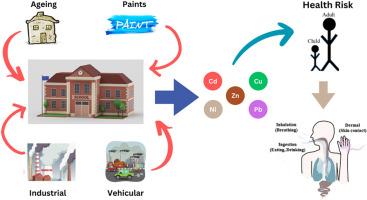Dust trace metals implications on school’s indoor air quality linked to human health risk at Khurianwala (Pakistan)
IF 4.2
2区 环境科学与生态学
Q2 ENVIRONMENTAL SCIENCES
引用次数: 0
Abstract
In an environment, trace metals (TMs) are characterized by high density and potential toxicity. Airborne dust particles distribute TMs in the environment including educational institutes that enters the human body and cause severe health issues. Therefore, this research aimed at quantifying the concentration of cadmium (Cd), copper (Cu), nickel (Ni), lead (Pb), and zinc (Zn) present in classroom dust and determine associated health risk through different environmental models by employing R-studio. Dust samples from 12 schools situated in rural and urban areas and close to the industrial zones in Khurrianwala, Faisalabad were analyzed on atomic absorption spectrophotometer. The results showed that the dust samples contained Cd, Cu, Ni, Pb, and Zn in ranges of 0.02–2.5, 2.5–24.3, 5.4–41.5, 3.6–55.8, and 5.8–146.7 mg kg−1, respectively. The geo-accumulation index indicated that dust samples were contaminated with Cd and Pb. The contamination factor revealed that Ni and Cu contamination was minimal in all schools, while Cd and Pb showed moderate to high contamination at each school. Excluding rural regions, the pollution load index was high in industrial zone and urban regions. The hazard quotient indicated a little chance of non-carcinogenic risk in children from dust ingestion. The non-carcinogenic health hazard range (HI < 1) and the total cancer risk range (10−6 < TCR ≤10−4) were inferior for cancer-causing in adults and children, respectively. Findings of the study suggested that assessing the health risk caused by TMs contaminated dust in the school environment is essential to avoid any health complications in adults and children.

微量金属粉尘对 Khurianwala(巴基斯坦)学校室内空气质量的影响与人类健康风险有关
环境中的痕量金属(TMs)具有高密度和潜在毒性的特点。空气中的尘埃微粒会在包括教育机构在内的环境中散发微量金属,进入人体后会导致严重的健康问题。因此,本研究旨在利用 R-studio 软件,通过不同的环境模型,量化教室灰尘中的镉(Cd)、铜(Cu)、镍(Ni)、铅(Pb)和锌(Zn)的浓度,并确定相关的健康风险。研究人员用原子吸收分光光度计分析了来自费萨拉巴德 Khurrianwala 城乡地区和工业区附近 12 所学校的粉尘样本。结果显示,粉尘样本中的镉、铜、镍、铅和锌的含量范围分别为 0.02-2.5、2.5-24.3、5.4-41.5、3.6-55.8 和 5.8-146.7 毫克/千克。地质累积指数表明,灰尘样本受到了镉和铅的污染。污染因子显示,镍和铜在所有学校的污染程度都很轻微,而镉和铅在每所学校都显示出中度到高度污染。除农村地区外,工业区和城市地区的污染负荷指数较高。危害商数表明,儿童因摄入粉尘而产生非致癌风险的几率很小。成人和儿童的非致癌健康危害范围(HI <1)和总致癌风险范围(10-6 <TCR≤10-4)分别低于致癌健康危害范围(HI <1)和总致癌风险范围(10-6 <TCR≤10-4)。研究结果表明,要避免成人和儿童的健康出现任何并发症,评估学校环境中受三卤甲烷污染的粉尘所造成的健康风险至关重要。
本文章由计算机程序翻译,如有差异,请以英文原文为准。
求助全文
约1分钟内获得全文
求助全文
来源期刊

Atmospheric Environment
环境科学-环境科学
CiteScore
9.40
自引率
8.00%
发文量
458
审稿时长
53 days
期刊介绍:
Atmospheric Environment has an open access mirror journal Atmospheric Environment: X, sharing the same aims and scope, editorial team, submission system and rigorous peer review.
Atmospheric Environment is the international journal for scientists in different disciplines related to atmospheric composition and its impacts. The journal publishes scientific articles with atmospheric relevance of emissions and depositions of gaseous and particulate compounds, chemical processes and physical effects in the atmosphere, as well as impacts of the changing atmospheric composition on human health, air quality, climate change, and ecosystems.
 求助内容:
求助内容: 应助结果提醒方式:
应助结果提醒方式:


